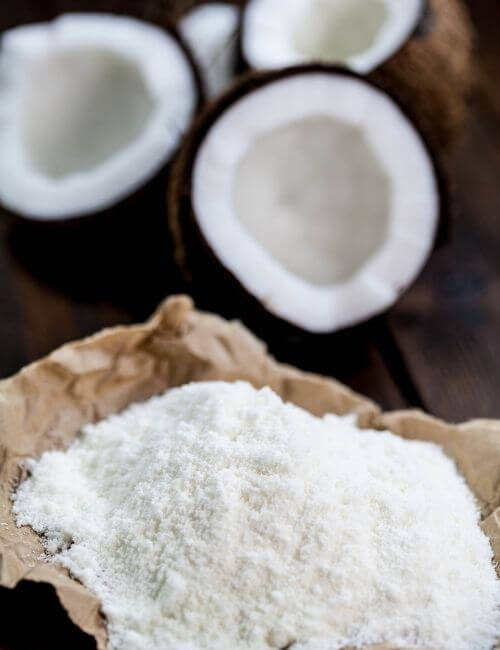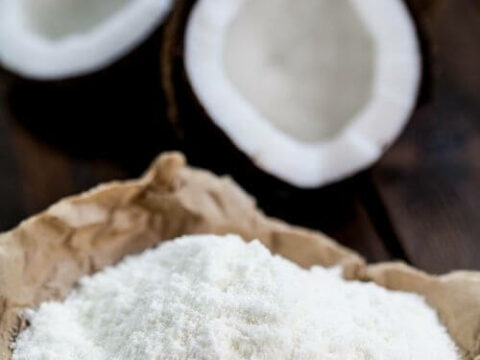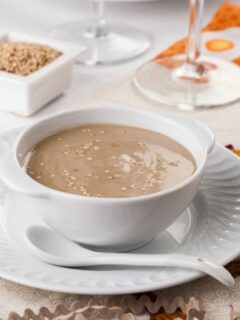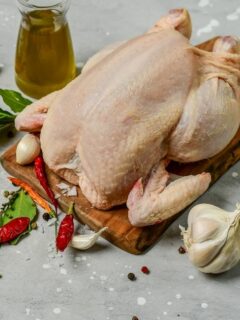Coconut flour is a nutritious and gluten-free flour. It is very popular for its health benefits and unique flavour.
In this article, we will learn what is coconut flour, its taste, benefits, uses and how to make coconut flour at home. Let’s dive into the delicious and nutritious realm of coconut flour.
Are you ready to learn about this gluten-free coconut flour? Let’s start.

Table of Contents
What is Coconut Flour?
Coconut flour is made from dried coconut meat. It is like finely ground coconut powder. It does not taste fully like coconut but it adds a nice, mild flavor to your dishes.
Coconut flour is a very healthy flour because it is packed with fiber and protein. Apart from that, it is also gluten-free and grain-free.
That’s why it is a great choice for people with allergies and dietary restrictions. So, if you are into healthy cooking or need a gluten-free alternative then coconut flour is the way to go.
What is Coconut Flour made of?
Coconut flour is made from the white fleshy part of mature coconuts. At first, this part is carefully dried out completely. Then ground into a fine powder.
The main important thing to make a good coconut flour is to completely dry white fleshy part before grounding. That way you get a smooth fine powder that is great for baking and cooking.
You can see it is a very simple process that turns coconut into coconut flour.
What does Coconut Flour taste like?
Coconut flour has a gentle, mild taste. It is not too strong so it won’t make your food taste like coconuts. Instead, it adds a pleasant hint of tropical flavor to your recipes. You can use coconut flour in both pancakes and gravy dishes.
Coconut Flour Vs Wheat Flour: What is the Difference?
Coconut flour and wheat flour have distinct differences. Here’s how:
Gluten Compound:
Coconut flour is gluten-free which means it is an excellent choice for those with gluten sensitivities. But, Wheat flour contains gluten that means it is unsuitable for those with gluten allergies.
Presence of Grain:
Coconut flour is grain-free but wheat flour comes from grains like wheat. This makes coconut flour a best choice for grain-free diets.
Textures
Coconut flour has a different texture compared to wheat flour. Coconut flour is more absorbent so you need less of it in recipes. It can give in a denser and moister texture in baked goods.
Nutritional Differences
Coconut flour is rich in fiber and protein. That’s why it is a nutritious choice among healthy people. But, Wheat flour is higher in carbohydrates.
So, when choosing between them always consider your dietary needs and the texture you want in your recipes.
You May Like
What is Coconut Flour substitute?
If you can’t find coconut flour or need an alternative then you can use different flours in its place.
Almond flour and tapioca flour can be a great substitute for coconut flour. Keep in mind, that each substitute may change the texture and taste of your recipes a bit. So choose them wisely based on what you are cooking.
Where to Buy Coconut Flour
You can find coconut flour in most grocery stores or buy it online. When shopping, check labels for quality and authenticity.
How to store Coconut Flour
Storing coconut flour is very simple process. To keep coconut flour fresh store it in an airtight container in a cool, dry place.
This container helps to keep moisture out and maintains the flour’s quality. Always avoid humidity places because moisture can make your coconut flour clumpy.
How to use Coconut Flour
You can use coconut flour in various ways. In baking, mix it with other flours for the best texture. Try it in pancakes, waffles or even as a coating for crispy chicken.
Expert Tips and Tricks to use Coconut Flour
If you want to use coconut flour in your recipes always remember below important points for better result.
Adjust Liquid ratios:
When you use coconut flour in recipes you may need to add more liquid. This keeps your dishes from turning out too dry. While adding liquide slowly add liquid to your batter or dough until you get the right consistency.
Let It Rest:
After mixing coconut flour into your recipes let the batter or dough rest for some time. This gives the flour time to soak up the liquid and gives you the best results.
Mix with Other Flours:
To get better texture in your recipes you can mix coconut flour with other flours like almond or tapioca.
What are the benefits of Coconut Flour?
Coconut flour is not just tasty it is also healthy. Below are the a few benefits of coconut flour.
Healthy Fiber:
It is rich in fiber which is good for your tummy and keeps you feeling full and satisfied.
Aids Digestion:
The fiber in coconut flour helps keep your digestion running smoothly.
Protein Power
Coconut flour packs a punch with protein which helps your body grow strong and repair itself.
Gluten-Free Goodness
For people with gluten allergies or sensitivities, As coconut flour is gluten-free. So it is a great choice among gluten allergies or sensitivities people.
Supports Grain- Free Diets
If you are into grain-free or paleo diets then coconut flour is the best choice for you. Because coconut flour doesn’t have any grain.
Coconut Flour Nutrition
Coconut flour has a lot of nutritional benefits. It’s a fantastic source of dietary fiber and protein, which can help keep your body feeling its best.
How to make Coconut Flour?
Making your own coconut flour at home is very easy process. Here is how you can do it:
Ingredients Need:
Mature coconuts
Grater
Oven or dehydrator
Blender
Sieve or fine mesh strainer
Homemade coconut flour recipe step by step
Collect the White Coconut Flesh:
At first, collect the white flesh from mature coconuts. Make sure it is clean and free from any brown skin.
Dry the Coconut:
Now, lay the white coconut flesh on a tray and put it in the oven or a dehydrator. Set the temperature to low and let the meat dry out until it’s completely moisture-free.
Grind into Powder:
Once dried take the coconut meat and put it in a high-powered blender. Blend it until it turns into a fine powder. You may need to stop and scrape down the sides a few times to make sure everything gets blended.
Sieve for Smoothness:
To get a smooth consistency sift the coconut powder through a sieve or fine mesh strainer.
Store Properly:
After sifting store your homemade coconut flour in an airtight container in a cool, dry place.
Now you have made your own homemade coconut flour ready to use in your favorite recipes.
Coconut Flour Recipes
For a taste of what coconut flour can do you can explore some popular recipes. Coconut Flour Pancakes, Banana Bread , Chocolate Chip Cookies , Chicken Tenders . These recipes showcase the creative and delicious side of using coconut flour.
In this article, we have learnt what is coconut flour is, it’s taste, benefits, how to make it and how to use it in your kitchen. Now you can use coconut flour in your baking and cooking properly to enhance their flavor.
What is coconut flour : How to make coconut flour

Do you know what is coconut flour? Here we will learn it's taste, benefits, uses and also learn how to make coconut flour at home. Are you ready to learn? Let's start?
Ingredients
- Coconut Flour
Instructions
How to make coconut flour
- Read all of the above instructions carefully about what is coconut flour.
- It also describes it's taste, benefits, uses.
- Understand all about tips and tricks to make homemade coconut flour.





